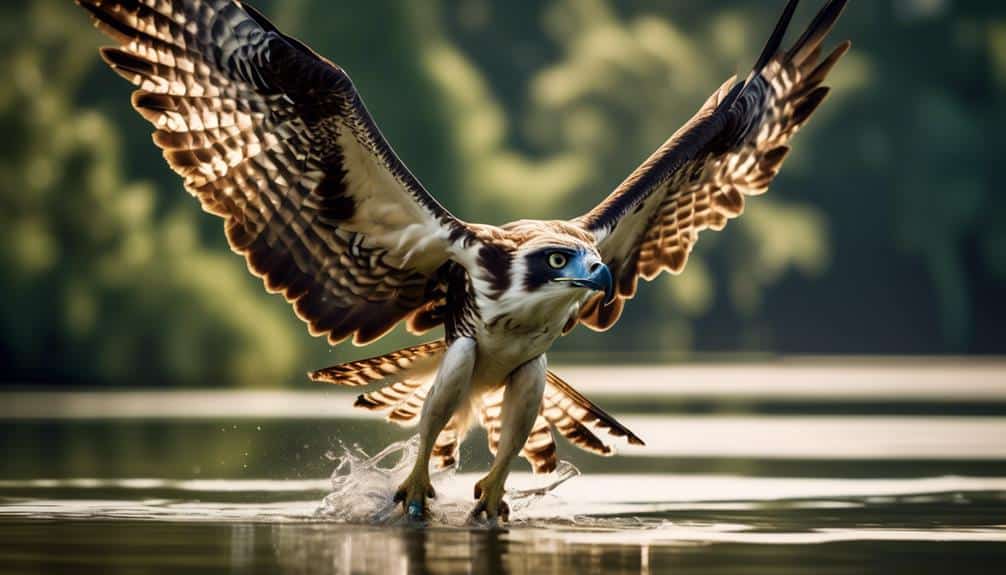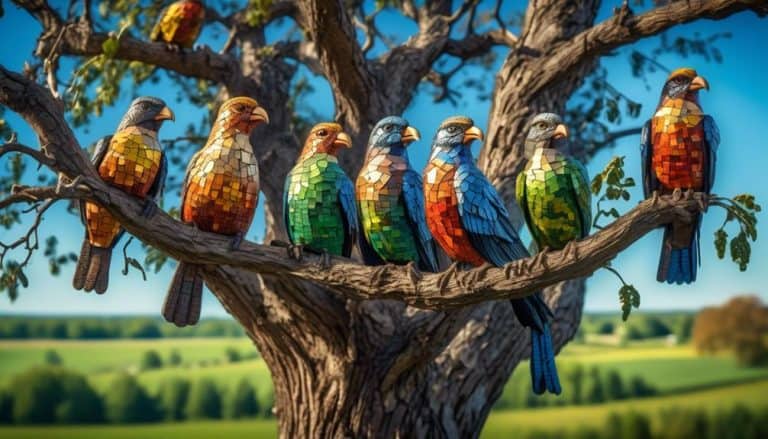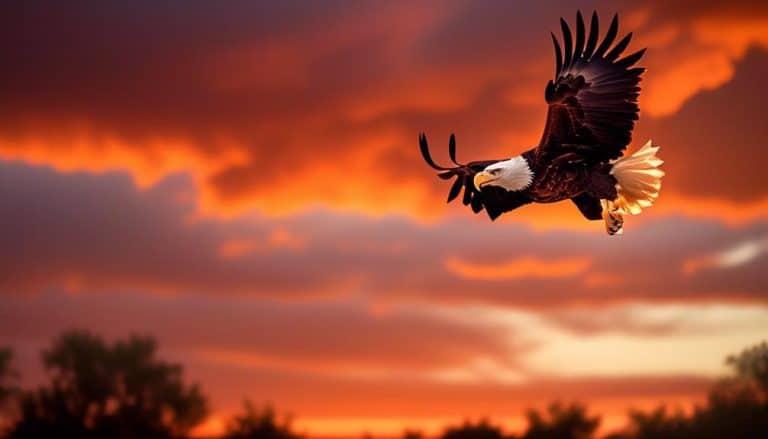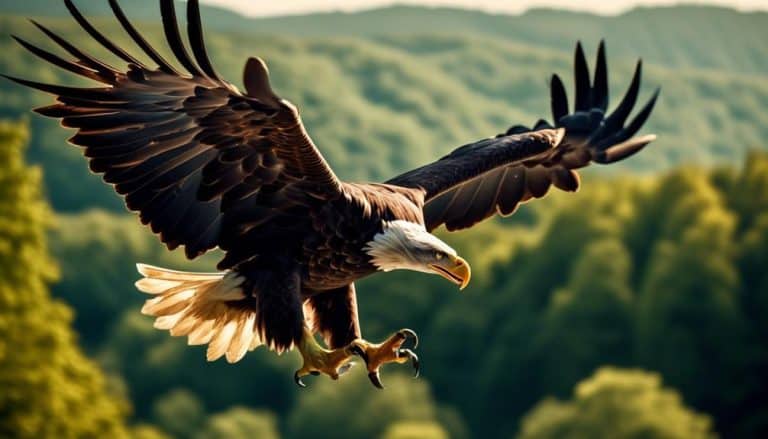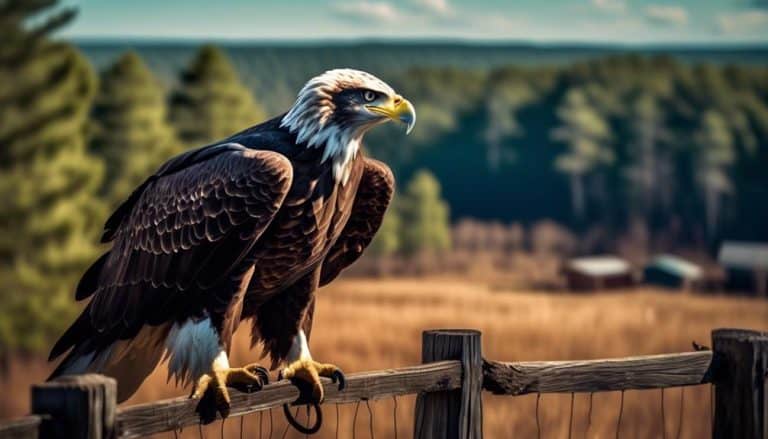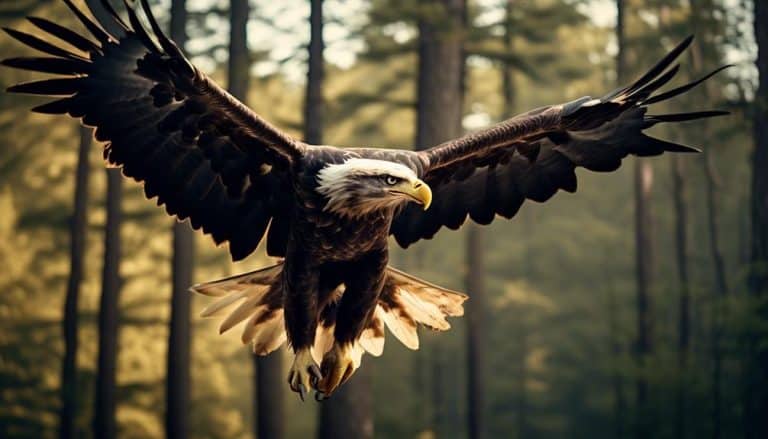As I observe the vast skies of Louisiana, I am captivated by the majestic presence of birds of prey soaring above. Bald Eagles, Red-tailed Hawks, Great Horned Owls, Ospreys, and Peregrine Falcons – each one possessing unique characteristics that make them formidable hunters in their own right.
These creatures of the sky hold a certain allure, a mysterious aura that begs to be explored further. But what secrets do they hold? What tales can they tell?
Join me as we uncover the fascinating world of Louisiana's birds of prey and discover the untold stories that lie within their wingspan.
Bald Eagles: The Symbol of Strength
Bald eagles, known for their majestic appearance and powerful hunting abilities, have long been recognized as a symbol of strength in the avian world. These birds of prey, with their striking white heads and impressive wingspans, represent more than just physical prowess. They've become a symbolic representation of conservation efforts and the importance of preserving our natural habitats.
The bald eagle's rise to iconic status can be attributed to its remarkable recovery story. Once on the brink of extinction due to habitat loss and the widespread use of pesticides like DDT, conservation efforts have successfully brought these magnificent creatures back from the brink. The banning of DDT and the establishment of protected areas have allowed populations to rebound, offering hope for other endangered species as well.
Today, the bald eagle serves as a powerful reminder of the importance of environmental conservation. Its presence in our skies and waterways signifies the health of our ecosystems and the success of conservation initiatives. By protecting their habitats, we not only ensure the survival of these incredible birds but also safeguard the countless other species that rely on the same environments.
Red-tailed Hawks: Masters of the Skies
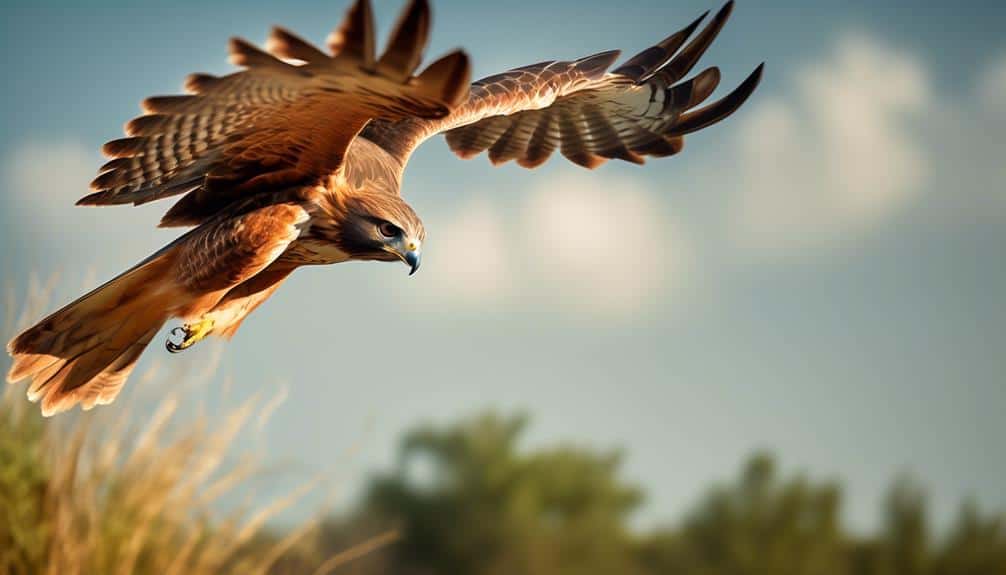
Red-tailed hawks, renowned for their exceptional aerial skills and keen hunting prowess, dominate the skies with their impressive presence. These majestic birds of prey can be found across North America, including the state of Louisiana. Let's explore the fascinating world of red-tailed hawks and delve into their migration patterns and hunting techniques.
- Migration Patterns: Red-tailed hawks are known to be highly migratory birds, with some individuals traveling thousands of miles each year. They breed in the northern parts of North America and migrate south during the winter months. In Louisiana, they can be seen during the colder months as they seek more favorable hunting grounds and milder climates.
- Hunting Techniques: Red-tailed hawks are skilled hunters, employing various techniques to catch their prey. They primarily rely on their exceptional eyesight to spot potential targets from great distances. Once a prey is detected, they soar high above their target before diving down with incredible speed and precision. Their sharp talons and powerful grip allow them to capture and subdue their prey, which typically includes small mammals, birds, and reptiles.
- Adaptations for Hunting: Red-tailed hawks possess several adaptations that aid in their hunting success. Their broad wings and fan-shaped tails provide excellent maneuverability and stability during flight, allowing them to navigate through complex aerial environments. Additionally, their sharp, curved beaks are perfectly suited for tearing flesh and consuming their captured prey.
Great Horned Owls: Silent Predators of the Night
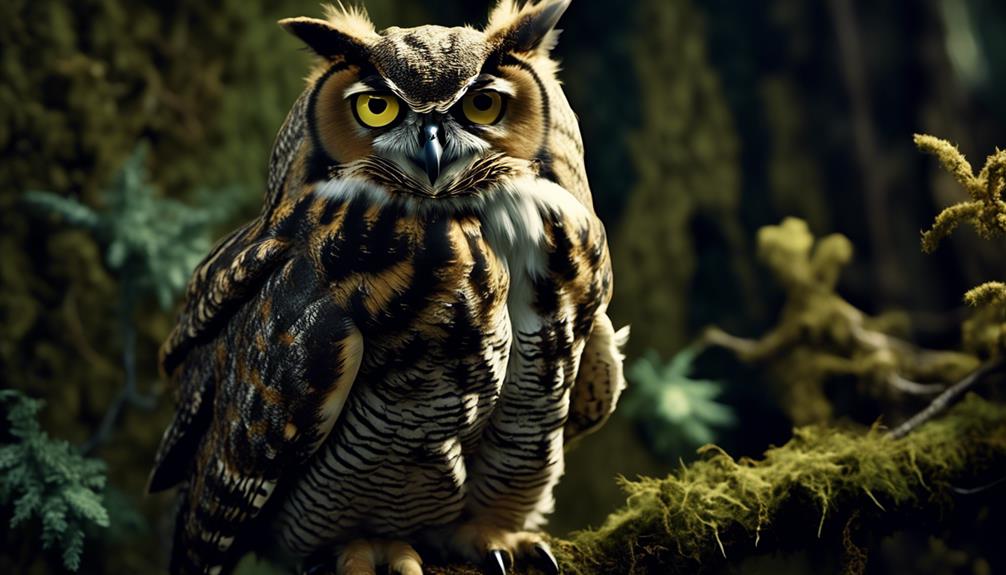
Great Horned Owls, known for their stealthy nocturnal hunting abilities, silently patrol the night skies of Louisiana. These majestic birds of prey have adapted remarkable camouflage techniques and exhibit fascinating hunting habits. Let's explore the intriguing world of the Great Horned Owls.
| Camouflage Techniques | Hunting Habits |
|---|---|
| Feather patterns and colors blend with their surroundings | They are opportunistic hunters and consume a wide range of prey |
| Fluffy feather tufts on their heads resemble ears and help break up their outline | Their powerful talons and sharp beaks aid in capturing and killing prey |
| Their large, yellow eyes provide excellent night vision | Great Horned Owls are known for their silent flight, enabling them to surprise their prey |
Great Horned Owls utilize their camouflage techniques to blend seamlessly with their environment. Their feather patterns and colors mimic the bark of trees, allowing them to remain undetected by both prey and potential predators. Additionally, their fluffy feather tufts on their heads, known as "horns," help break up their outline and further enhance their camouflage.
When it comes to hunting, Great Horned Owls exhibit remarkable adaptability. They are opportunistic hunters and have a diverse diet, ranging from small mammals like mice and rabbits to birds, reptiles, and even other owls. Their powerful talons and sharp beaks enable them to capture and kill their prey swiftly and efficiently.
One of the most fascinating aspects of Great Horned Owls is their silent flight. Their specialized feathers allow them to fly noiselessly through the night, making them exceptional ambush predators. This stealthy approach ensures that their prey remains unaware until it is too late.
Great Horned Owls, with their incredible camouflage techniques and hunting habits, exemplify the wonders of nature's design. As they continue to silently patrol the night skies of Louisiana, these majestic predators remind us of the intricate balance of the natural world.
Ospreys: Agile Fishermen of Louisiana's Waterways
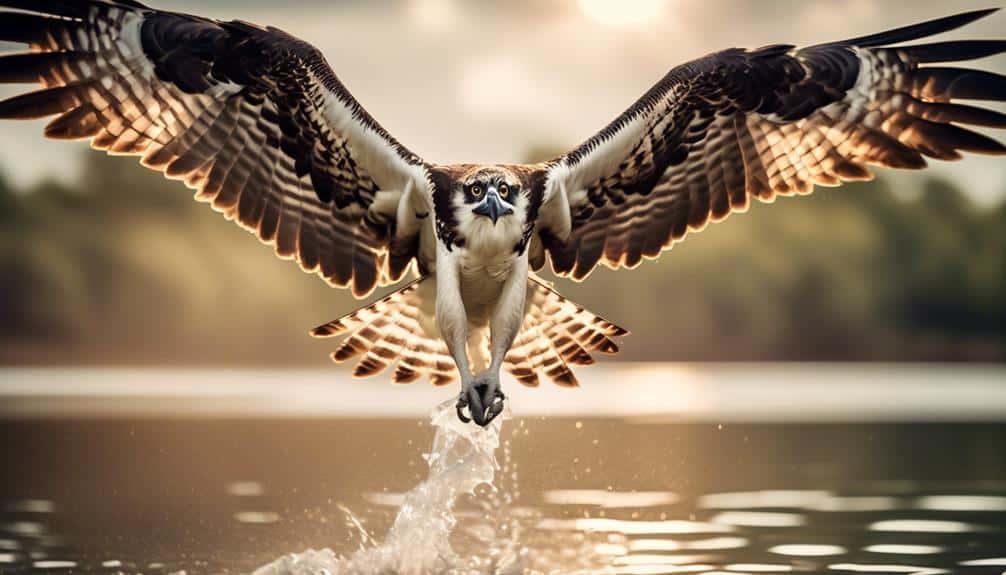
Ospreys, known for their agile hunting skills and mastery of Louisiana's waterways, are skilled fishermen that dominate the aquatic landscape. These magnificent raptors have adapted to their environment and developed remarkable techniques to catch fish with precision and efficiency. Here are three fascinating aspects of their behavior:
- Dive-bombing: Ospreys exhibit remarkable agility when hunting. They soar high above the water, using their keen eyesight to spot fish beneath the surface. Once a target is identified, they fold their wings and dive headfirst, plunging into the water with incredible speed. Their powerful talons extend just before impact, ensuring a firm grip on their slippery prey.
- Adaptive Feet: Ospreys possess unique feet specially adapted for fishing. Their feet have sharp, curved talons, with reversible outer toes and spiky pads. These adaptations allow them to firmly grasp fish while in flight and prevent them from slipping away.
- Nesting Habits: Ospreys build their nests in tall trees, atop utility poles, or even on man-made structures like platforms and buoys. These large nests are made of sticks and lined with softer materials such as moss, grass, and seaweed. Ospreys are known to return to the same nesting site year after year, reinforcing and expanding their structures.
With their agile hunting techniques and interesting nesting habits, Ospreys are remarkable creatures that have adapted to thrive in the unique ecosystems of Louisiana's waterways.
Peregrine Falcons: The Fastest Birds on Earth
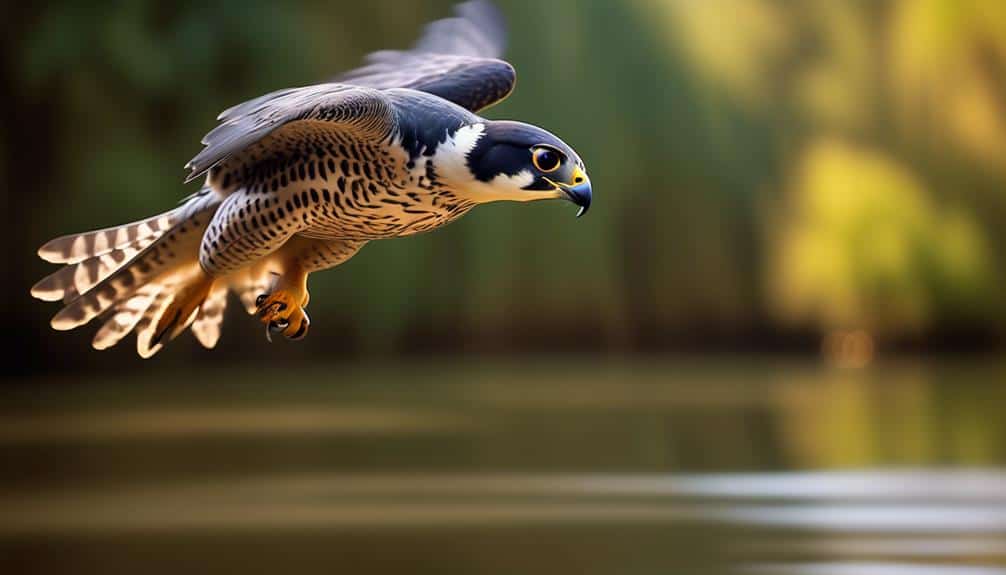
With their impressive hunting abilities and fascinating nesting habits, Ospreys showcase the remarkable adaptations of birds of prey in Louisiana; however, another avian predator takes the spotlight as the fastest bird on Earth – the Peregrine Falcon.
Known for its astonishing speed and agility, the Peregrine Falcon holds the title for being the fastest bird in the world. In level flight, this magnificent bird can reach speeds of up to 240 miles per hour, making it a true marvel of nature. These speed records are achieved during hunting dives, also known as 'stoops,' where the Peregrine Falcon tucks its wings close to its body and plummets towards its prey. This hunting technique allows the falcon to strike its target with unrivaled force, ensuring a successful catch.
The Peregrine Falcon's exceptional vision, combined with its incredible speed, enables it to spot prey from great distances and execute precise aerial maneuvers. It primarily hunts medium-sized birds, such as pigeons and ducks, but has been known to target other prey as well. The Peregrine Falcon's unparalleled speed and hunting techniques make it a true marvel of the avian world.
Frequently Asked Questions
How Many Bald Eagles Are There in Louisiana?
There are approximately 500 bald eagles in Louisiana. Conservation efforts for Louisiana birds of prey, including the bald eagle, focus on protecting their habitats, monitoring populations, and educating the public about these majestic creatures.
What Is the Lifespan of a Red-Tailed Hawk?
The lifespan of a red-tailed hawk varies, but on average they live for around 10-15 years. These magnificent birds are known for their hunting prowess, nesting habits, and distinctive red tails.
Do Great Horned Owls Hibernate During the Winter Months?
No, great horned owls do not hibernate during the winter months. They are active year-round and have adapted to survive in cold weather. Their winter behavior includes hunting for food and finding shelter.
How Deep Can Ospreys Dive to Catch Fish?
I've researched and found that ospreys are incredible divers, capable of plunging up to 3 feet into the water to catch fish. Their fishing techniques and the osprey population in Louisiana are fascinating subjects to explore.
What Is the Maximum Speed That Peregrine Falcons Can Reach During a Dive?
During a dive, peregrine falcons can reach a maximum speed of over 240 miles per hour. Their incredible hunting techniques, including this high-speed dive, make them one of the most skilled predators in the animal kingdom.
Conclusion
As I conclude my exploration of Louisiana's birds of prey, I'm struck by the majestic beauty and awe-inspiring abilities of these remarkable creatures. They soar through the skies with grace and power, embodying the true essence of strength and resilience.
Each bird, from the Bald Eagle to the Peregrine Falcon, has its own unique qualities and specialized hunting techniques. They're nature's masterpieces, reminding us of the extraordinary diversity and wonder that exists in our world.
Just as these birds conquer the skies, may we too find the strength to overcome any challenges that come our way.

